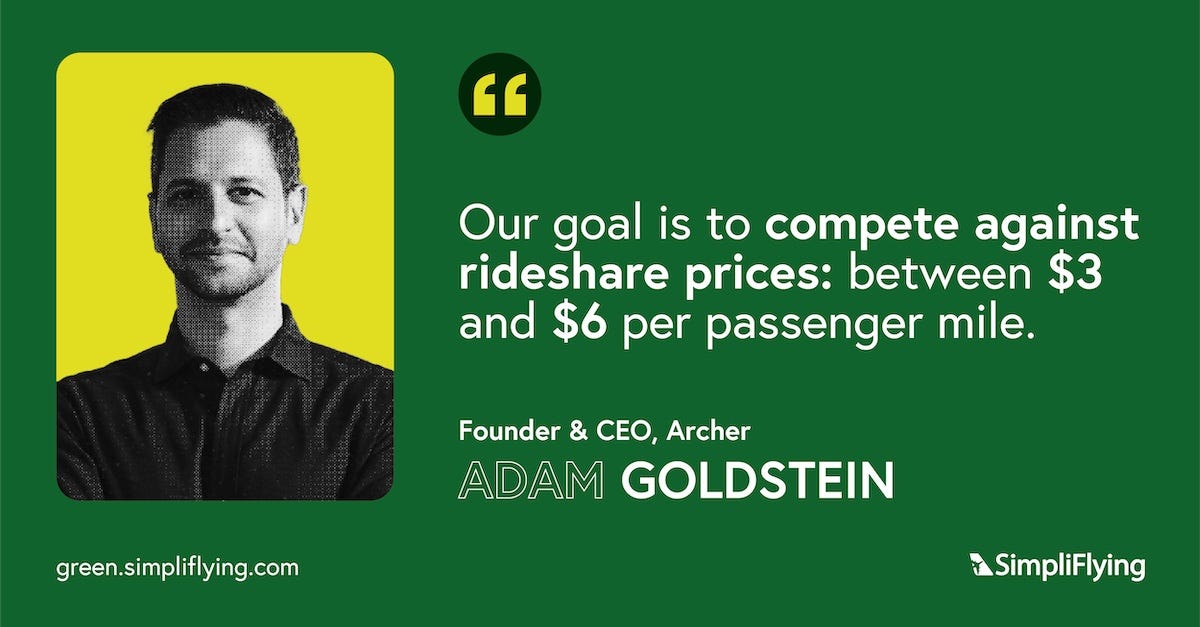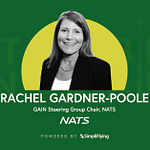Welcome to Season 3 of Sustainability in the Air, the world’s first podcast dedicated to sustainable aviation. Through in-depth conversations with top aviation leaders, we break through the clutter and provide a clear roadmap for a net-zero future.
eVTOLs (electric vertical takeoff and landing) or ‘air taxis’ refer to aircraft that use electric power to take off and land vertically, and are particularly useful in urban areas afflicted with traffic congestion. Once these electric propulsion aircraft take to the skies, they promise to make urban air mobility greener and offer significantly quieter flights compared to today’s helicopters!
American aerospace company Archer Aviation focuses on designing and developing eVTOLs, which they believe will “unlock the skies” and enable everyone to reimagine how they live, travel and manage time.
In this episode of our ‘Sustainability in the Air’ podcast, Archer Aviation’s Founder and CEO Adam Goldstein speaks with SimpliFlying CEO Shashank Nigam and shares how the startup is leading eVTOL commercialisation through incremental and innovative technologies that aim to make air travel greener.
When he launched the startup in 2018 with Brett Adcock, Goldstein’s approach was very different from the standard eVTOL industry practice that focused heavily on R&D. Archer, on the other hand, took a very hands-on route to build and commercialise, and was the first to go public. Notably, Archer was Goldstein’s first foray into aviation. Before founding Archer, Goldstein founded – and later sold – the hiring marketplace Vettery.
You can listen and subscribe to our podcast on all major podcast platforms or read our deep dive into the episode below.
How to build eVTOL infrastructure (5:40)
Why eVTOLs are much better than helicopters (8:28)
What will an eVTOL ride cost? (11:22)
Re-imagining the passenger experience and discarding legacy elements (13:55)
The future of battery technology (18:18)
How do people perceive eVTOLs? (22:32)
The path to FAA certification (24:52)
Where will Archer find hundreds of pilots? (27:20)
Competitors and challenges (30:00)
What’s next after “Midnight”? (35:06)
Rapid Fire! (39:42)
Shortcut to the future
The next phase of Urban Air Mobility (UAM) platforms may have seemed like a pipedream for a while. However, in November 2022, United Airlines and Archer Aviation demonstrated that the future is closer than we think. Thanks to Archer’s upcoming eVTOL aircraft, named Midnight, United plans to commence commercial eVTOL flights as soon as 2025.
Goldstein says these vehicles – which can carry four passengers and a pilot – will not only change the way people move but also allow people to get a lot of time back. “Imagine the trips that you’ve been taking in your car – it would take you 60, 90, even 120 minutes of sitting in traffic. But you could instead fly to your destination in five or 10 minutes”, he asserts.
The inaugural route has already been announced – Newark Liberty International Airport (EWR) to the Downtown Manhattan Heliport in New York City in 10 minutes. Archer plans to complete certification of its aircraft – whose development is progressing faster than expected – by 2024, and build over 250 aircraft in 2025. “It’s a very exciting time in the industry”, declares Goldstein. “As the technology has matured, the regulators are all lined up to certify these vehicles, and there’s finally enough capital to actually get it done.”
Better together
Archer, of course, has benefitted immensely from its partner and champion, United Airlines. Two years ago, United announced that it would not only invest over $1b in the eVTOL company, it would also acquire up to 200 aircraft and share expertise that would accelerate development. Goldstein says United has made it really clear that sustainable aviation is very important to them. “And we really help them fulfil that mission”, he says. “[They believe] we have a vehicle that has a really straightforward path to certification and entry into service. [They can] conserve a lot of their best customers in their big hubs.”
“The goal is how do we create a new form of transportation that people can use every day rather than something that’s only available for a select few?”
While Archer is working on more routes across other hubs with United, Goldstein points out that planning a new route involves working with multiple partners, stakeholders, regulators and local communities. For example, for the announced route, Archer worked with Mayor Adams (of New York) and the Port Authority and a number of different groups. “Because there are a lot of constituents involved who need to understand the product and understand the value we will deliver”, he explains.
In addition, site selection is actually a delicate process that involves thinking through the entire customer journey and reducing friction as much as possible. Goldstein says the whole journey needs to be considered, not just the actual flight itself: “So you can imagine your plane lands, you pull up to the gate and you get off. There’s another gate nearby, you go down and you get into another plane. And that plane takes off and takes you back to Manhattan”, he says. Archer is planning to expand into multiple areas using existing infrastructure. However, they will also work on building future infrastructure points, in order to make the service available to many more people.
No longer heli-centric
Goldstein insists that helicopters have always been a restricting factor in UAM. The challenge with helicopters is three-fold: they’re very noisy, expensive to run and limited in supply. “But the beauty of eVTOLs is that these aircraft are actually very quiet. So that allows us to put more aircraft in the air”, he says. In effect, that would allow Archer to put more aircraft in the air and not service just high net worth folks.
“If we had enough planes that were just flying, it would almost be like an air gondola. You just show up, hop on a plane and go – that’s the ultimate vision, where there’s really low friction.”
Moreover, eVTOLs are much less complex than helicopters – they use fewer parts, the maintenance is much lower, and, as a result, the cost of these vehicles can be driven down. Essentially, not only will eVTOLs be lower cost, but they can be utilised more because they’re not maintenance heavy. “Which means we can spread the fixed cost over a greater user base, allowing more people access to them”, he argues.
Our Take
We have known of UAM as a promising concept for a few years now. Initially led stutteringly by helicopters servicing a tiny elite, the new vision is led primarily by eVTOL aircraft. These air taxis, as they are popularly known, promise to bring all our Jetsons dreams true by changing the nature of flying itself – by shortening painfully long routes, decongesting roads, while being futuristic and attractive to boot. The clincher: they will run on clean energy, will be nearly noiseless, and usher in a truly green era in aviation that will be accessible to the common man.
The future of green aviation demands that we innovate and improve our technologies continuously. Archer’s initial aim is to get to market as quickly as possible, to leverage the first-mover advantage. However, as Goldstein explains, in the long run, continuous and incremental enhancement will guide its eVTOL manufacturing.
Moreover, since big aerospace remains rooted in legacy processes and technologies, and functions essentially as a duopoly, eVTOLs might prove to be a necessary change. Such radical innovations can shake up the status quo and set fire to a series of innovations that might prove to be the need of the hour.
As Archer prepares to test its Midnight aircraft in 2024, we look forward to turning the corner – from the age of the Jets to that of the Jetsons.
Our Sustainability in the Air podcast is powered by SimpliFlying which has been helping build trust in travel for over a decade.
This season of the podcast is brought to you by Cirium and CarbonClick. As a sustainability partner, Cirium helps the aviation industry gain a much clearer view of carbon emissions and develop methods to reduce them, enabling on the industry promise to fly sustainably. CarbonClick is the industry leader in managing transparent carbon offsetting programs for individuals and top global airlines.














